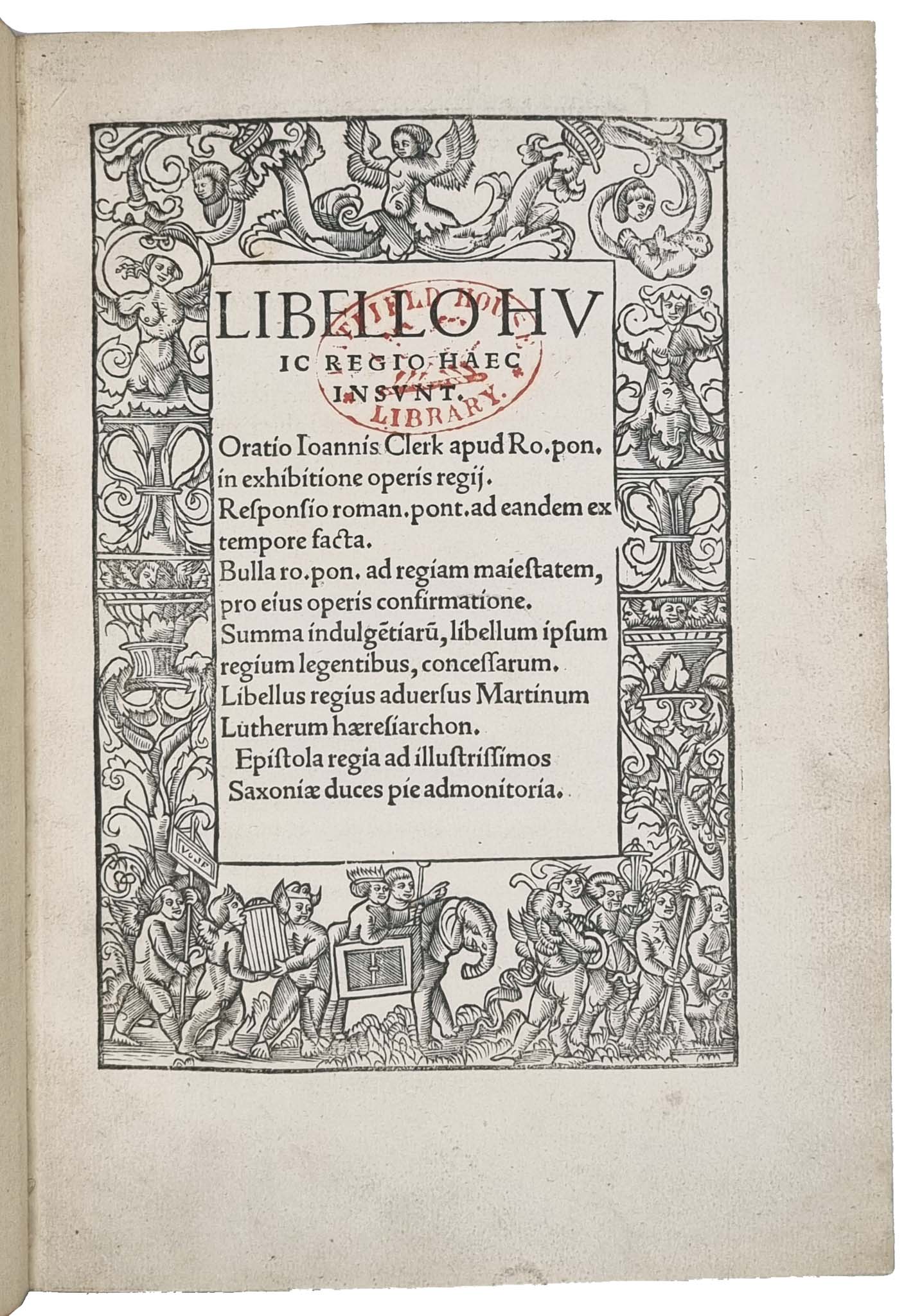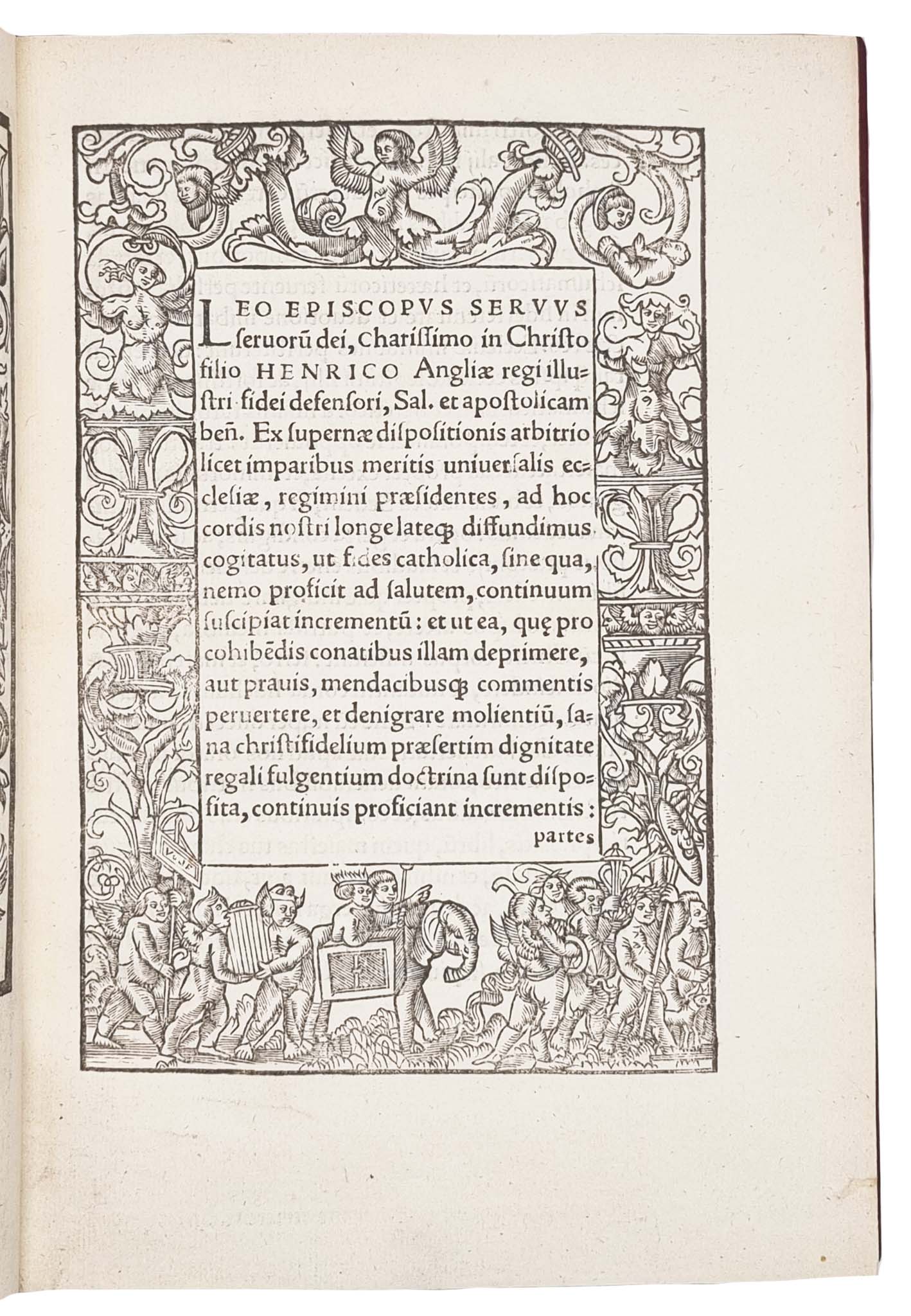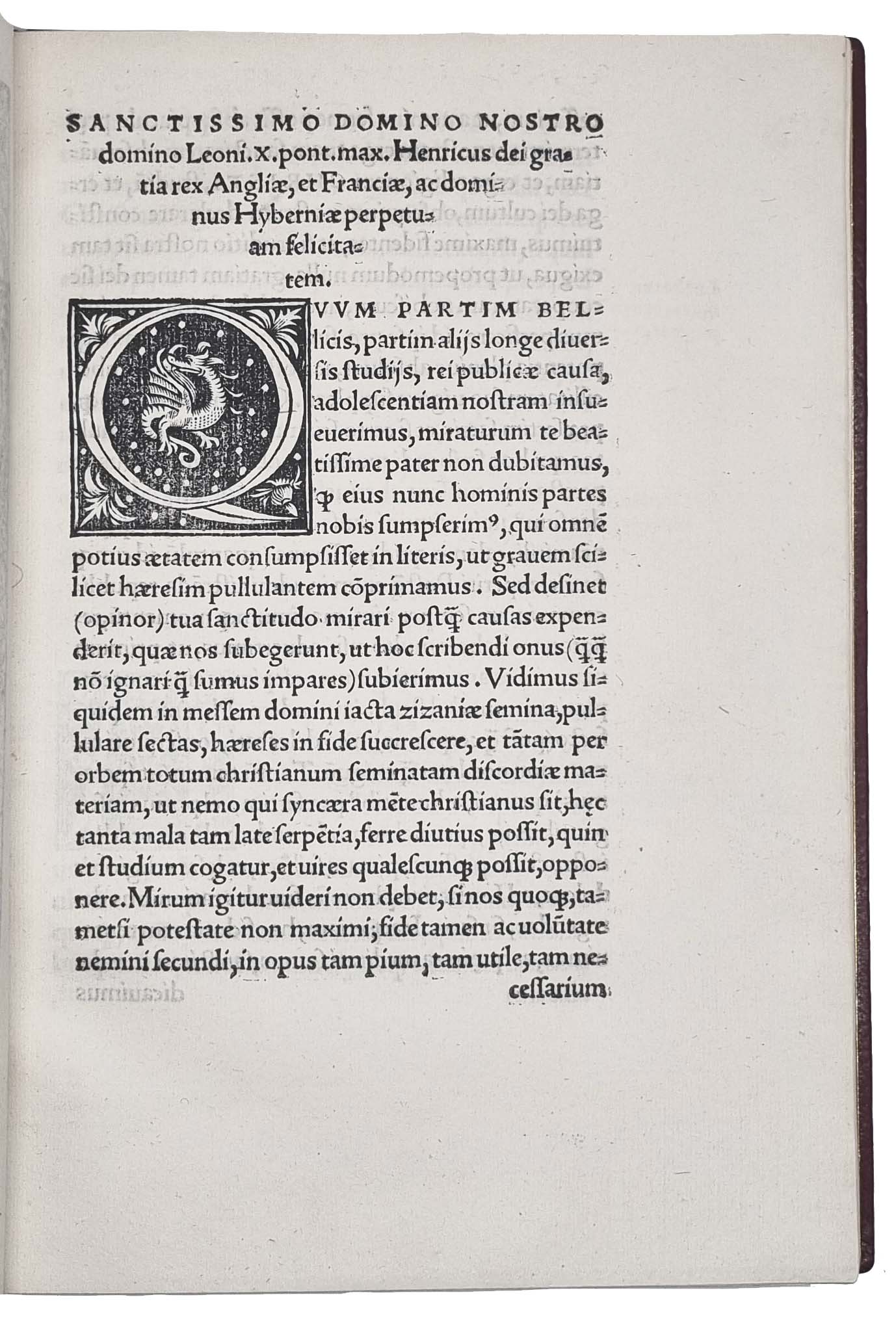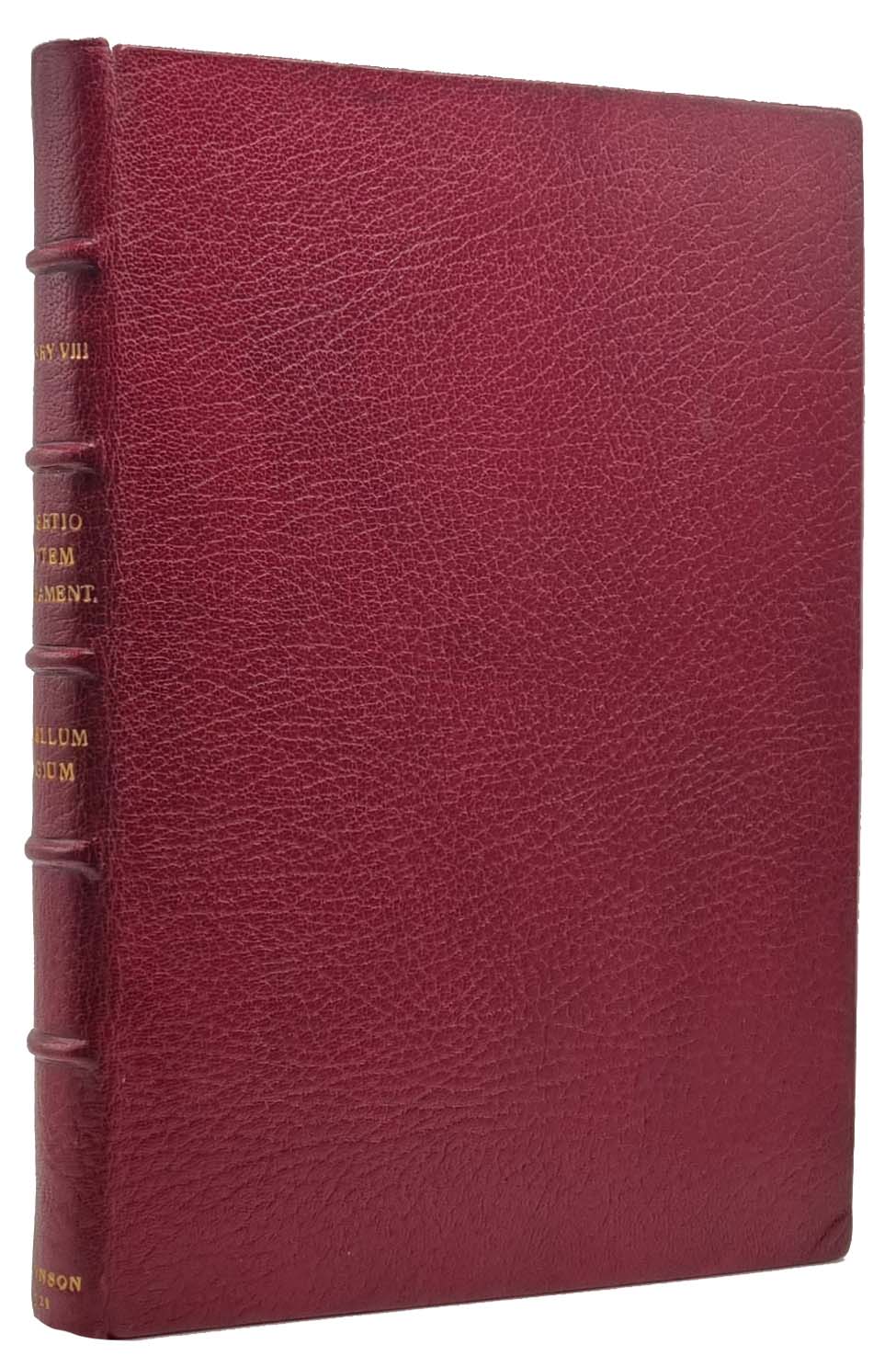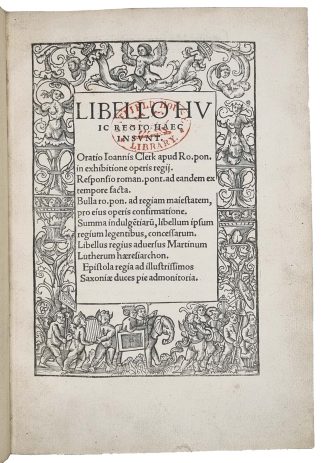HENRY VIII
HISTORIC PROVENANCE
Libello huic regio haec insunt. Oratio Ioannis Clerk apud Ro.pon.in exhibitione operis regij.
London, In ædibus Pynsonianis, quarto idus Iulij, 1521£52,500.00
FIRST EDITION thus. 4to. 3 parts in one volume. 72 unnumbered leaves. A-C , [a] , b-u , ²a-b . [C4, v3, v4 and ²b4 are blank; wanting blanks C4, v4] Titles to parts 2 (‘Assertio septem sacramentorum aduersus Martin. Lutherum’ [a]1r), and 3 (‘Epistola regia’; 2a1r) within a fine historiated woodcut border signed HH and copied from Hans Holbein’s (McKerrow & Ferguson 8), general title (A1r) and pages C1r, and C3v within a fine historiated woodcut border (McKerrow and Ferguson 11), B4r within woodcut border (McKerrow and Ferguson 7), seven beautiful white-on-black criblé woodcut initials (with dragons and unicorns etc.) “Part 2 is a reissue of STC 13078. Parts 1 and 3 have no colophon. In part 1 (STC 21307a is part of this) the bull naming Henry ’fidei defensor’ is dated 5 id Oct. 1521, so this part was printed sometime later. Part 3 (Epistola regia) was apparently not written until March 1522, and it seems possible that parts 1 and 2 were made available before part 3 was printed” STC. Library stamp of Hatfield House on t-p., gilt morocco armorial label of Lloyd Tyrell-Kenyon, fifth Baron Kenyon (1917–1993) on pastedown, Louis H. Silver’s (1902–1963) label below, Charles Caldwell Ryrie below. Very light dust soiling to outer margin of first t-p. A fine copy, absolutely crisp and clean, on fine thick paper, in modern crushed morocco by J. P. Gray, Cambridge, spine with blind ruled raised bands, gilt lettered direct in compartments, edges gilt ruled, turn ins gilt ruled.
A stunning copy of this important and extremely rare collection of works by Henry VIII, published to coincide with announcement of his gaining the title ‘Fidei Defensor’ from the Pope. Henry’s ‘Defense of the Seven Sacraments’ against the challenge of Martin Luther was “one of the most successful pieces of Catholic polemics produced by the first generation of anti-Protestant writers,” Scarisbrick, ‘Henry VIII’, going through some twenty editions in the sixteenth century, and, as early as 1522, had appeared in two different German translations. One of Luther’s many pronouncements was that there were only two sacraments rather than the traditional seven. The ‘Defence’ was written by Henry probably with the assistance of Thomas More. The extent of More’s involvement with this project has been a point of contention since its publication. The work was also included in John Fisher’s works indicating he might also have had a hand in its production. Henry started to write in 1519 while he was reading Martin Luther’s attack on indulgences. By June of that year, he had shown it to Thomas Wolsey, but it remained private until three years later, when the earlier manuscript became the first two chapters of the Assertio, the rest consisting of new material relating to Luther’s De Captivitate Babylonica. It was dedicated to Pope Leo X, who rewarded Henry with the title Fidei Defensor (Defender of the Faith) in October 1521, a title revoked following the king’s break with the Catholic Church in the 1530s, but re-awarded to his heir by the English Parliament, and still used by the present monarchy.
“‘The Babylonian Captivity of the Church’ was published by Melchiot Lotther in Wittenberg on October 6, 1520. Of the three great Reformation treatises which Luther produced in 1520-1521, it is, in the exactest sense of the word, the most devastating for the church, not only in its sustained and profoundly serious criticism of the sacraments, above all that of the mass and its abuse, but as well for the fact that it ‘also raised the fundamental question of authority in the church’. In Worms, slightly over four months later, the papal nuncio Aleander knew that the young Henry VIII of England “intended to write a book on Luther’s errors”. His motives, to be sure, were by no means exclusively or even primarily theological, for “ever since the beginning of his reign he had hankered after a resounding title”; a defence of the sacraments, if approved by the pope, might earn him one. His work was completed, as a matter of fact actually published, on July 12, 1521, but probably circulated only after October 11, the day on which he became ‘Fidei Defensor’”. John M. Headley ‘The complete works of St. Thomas More, Responsio ad Lutherum.’
The work is very finely printed by Pynson, on the highest quality paper, with a beautiful Roman type very much in the style of the Basel printer Froben. The title pages have a wood-block border which is a copy of a design by Hans Holbein the Younger made for Froben. It illustrates a children’s triumphal procession above, and the story of Mucius Scaevola before Porsenna below. The wood cutter for the original block was Hans Herman, but it is not known who made this English copy.
Hatfield house is the oldest seat of the Cecil family who produced England’s first two prime ministers, to Elizabeth I and James I respectively.
ESTC S110238. STC 13083. Lowndes. II 906. Ames. 613, 614, 615In stock


